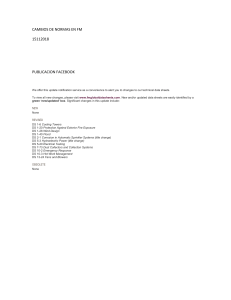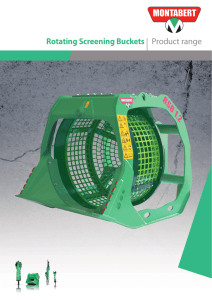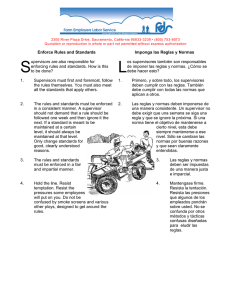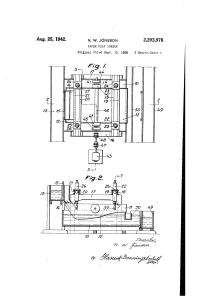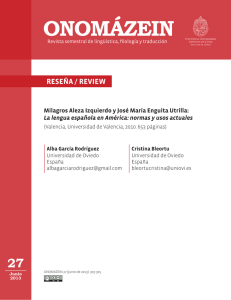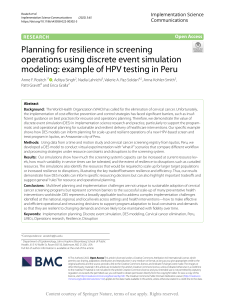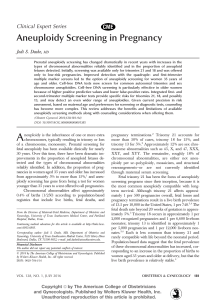Competition in Mexican Airlines
Anuncio
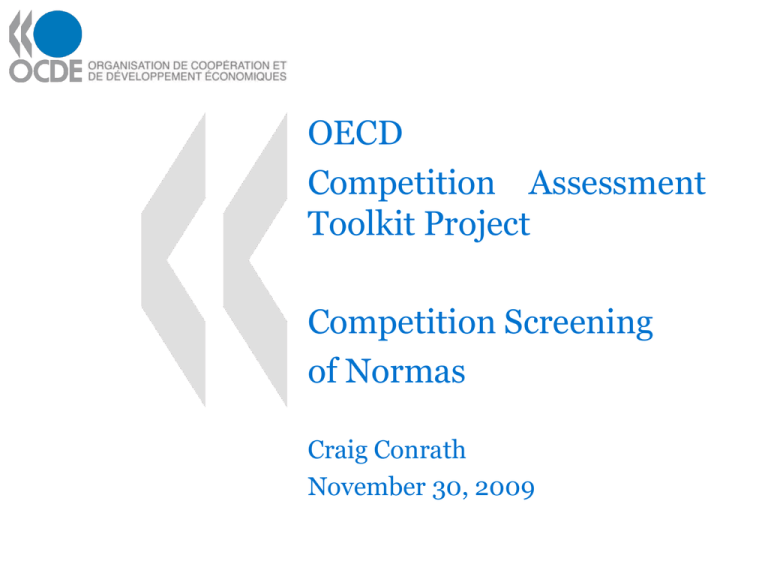
OECD Competition Assessment Toolkit Project Competition Screening of Normas Craig Conrath November 30, 2009 Outline of Presentation i. ii. iii. iv. v. Purpose & objectives Competition concerns Screening for competition concerns Preliminary screening results Conclusions and recommendations 2 I. PURPOSE & OBJECTIVES 3 Purpose & Objectives • Deliverable from the CFC-OECD Competition Assessment Toolkit project. Begun July 2009. • Screening of random sample of normas (NOMs & NMXs) – Applies OECD Competition Assessment Toolkit Checklist – Also applies Toolkit analysis to possible justifications for the normas 4 II. COMPETITION CONCERNS 5 Competition Concerns • Normas: Essential tools for public policy objectives. • BUT: Normas also can be over-restrictive and harmful to competition and competitiveness. • A self-interested minority can obtain normas that harm consumers as a whole, especially if each consumer is harmed only a little. • Broad set of product quality standards may have made sense in an economy with state ownership and limited competition. But they may be outmoded and restrict competition, especially when there is potential for innovation, new production methods, or product variation -- impeded by existing standards. 6 Competition concerns • Risks normas can present to competition: – Incumbent competitors may seek normas that: • Prevent new competition/raise costs of new entry • Limit how they compete with each other, preventing innovation and reducing consumer choice • Reduce the incentive for vigorous competition – Unnecessary standards may be imposed by normas to address issues that could easily be solved by the market. 7 Productivity and Growth • "Increasing productivity is by far the most important ingredient in economic development. It solves almost all the other economic problems. From the vast amount of economic experience in countries all over the world for the past 50 years, we have learned without doubt that the most important condition necessary for rapid productivity growth is fair and intense competition in all sectors of the economy." -William W. Lewis, Founding Director, McKinsey Global Institute, Author of The Power of Productivity 8 Competition Concerns: Scope • NOMs: Officially enforceable, clear potential to restrict competition • NMXs: Even non-enforceable norms can restrict market behavior & competition if: • There is private enforcement. • They are used as a reference for other decisions, e.g., permits, imports, access to trade ass’n, etc. • They become so widely adopted or accepted that noncomplying firms are impeded. • They are used in government purchasing specifications. • They become enforceable by reference in a NOM. 9 III. SCREENING FOR COMPETITION CONCERNS 10 Screening for Competition Concerns • Why screening? • Approximately 5400 normas – 800 NOMs – 4600 NMXs • PEMEX, CFE normas not screened • Random sample of 120 normas – 8% sample of NOMs – 1% sample of NMXs • Screening is a tool to focus future work. 11 Approach NOMs NMXs OECD Competition Assessment Toolkit Checklist Competition restricted No significant competition restriction Toolkit screening of justification for restriction “Zero-based analysis” Additional Competition Analysis Regulatory Improvement Review? 12 Principles Applied in Screening I • Preference for competition • Preference for market or private solutions • Government intervention needed only for significant market failures • When regulation is needed, a less restrictive alternative is preferable 13 Principles Applied in Screening II Presumption for competition: Burden of proof on advocates of government restrictions of competition 2009 Informe de Presidente Calderón: • “Octavo. Emprenderemos en el Gobierno una reforma regulatoria de fondo; un proceso que nos permita derogar todos aquellos acuerdos, oficios, decretos o reglamentos cuya necesidad no quede clara y plenamente justificada. De lo que se trata, es de facilitar la vida de los ciudadanos, de simplificar todos los trámites que realizan las empresas, de acercar el Gobierno a las necesidades de la gente.” 14 Australia applied the same principle in its extensive review of competition restrictions Presunción de aplicación universal de principios de competencia Excepciones deben justificarse por razones de interés público Mínima carga regulatoria 15 Fuente: National Competition Policy, Report by Independent Committee of Inquiry (Reporte Hilmer), p. 87 Tools Used in Screening • OECD Competition Assessment Toolkit – Tool to identify and evaluate competitionrestricting regulations – Issued 2007 after multicountry consultation – In 13 languages – Has been used in 20 countries 16 Competition Screening • OECD-created normas database: Toolkit Screening of NOMs, NMXs • Applies Toolkit principles to normas • Series of objective or simple questions to apply to each norma • Screening • Based only on text of the norma and general knowledge • Not a full analysis 17 Methodology • I. Identifying information – Name, number, date, industry, agency, etc. • II. Does the norma restrict competition? – Competition Assessment Toolkit Checklist • III. Potential justifications? – Applies Toolkit principles and analysis: considers possible market failures, etc. • IV. Initial evaluation – Evaluates justifications, possible reforms 18 Database 19 Database 20 IV. PRELIMINARY SCREENING RESULTS 21 Preliminary Screening Results • Screening: descriptive data (part I) • Review of 120 normas: • Size of affected market – 39 Large – 32 Medium – 30 Small (+ 19 unclassifiable) • 32 Multiple markets • 19 Markets with prior antitrust history 22 Preliminary Screening Results • Screening: Competition Checklist (part II) • Review of 120 normas • (Includes Double Counting) – 11 Restrict number or range of suppliers – 9 Restrict ability to compete • 19 more may restrict ability to compete – 0 Restrict incentive to compete vigorously 23 Preliminary Screening Results 24 Preliminary Screening Results • Potential Justification (part III) • Market failure or no? • When potential justification is consumer protection or consumer confusion (48 normas), in – 52% it seems probable that consumers themselves could detect quality – 10% more it seems probable that intermediaries could detect quality 25 Preliminary Screening Results • Initial Evaluation of 120 normas – 53% No significant competition restriction – 8% Significant competition restriction appears justified – 3% Appear likely justified with a change – 13% Candidates for elimination – (fewer than 100%; some are in other categories) • 17% of NOMs appear to have less restrictive alternatives available • (including voluntary standards) 26 Preliminary Screening Results • Case Study 1: Galletas de Animalitos (NMX-F379-S-1980) – Potential to restrict competition from any non-compliant animal cookie? – Any legitimate regulatory interests (health and safety) covered by broader regulations of, e.g., food products, or bread products (NMXF-521-1992) , or cookies (NMX-F-006-1983). – Candidate for elimination. • Cf.: Galletas Marias NMX-F-376-S-1980 27 Preliminary Screening Results • Case Study 2: Dog raisers/trainers (NOM-148-SCFI-2001, -2008) – Example of potential regulatory improvement • 2001 norma highly restrictive – Mandatory standard contracts – Extensive paperwork requirements – 10 pages, 111 subparagraphs • 2008 revision: less anticompetitive alternative – Competition Assessment Screening 5.5: » “Posibles Alternativas Menos Restrictivas” • Freedom to individualize contracts • Fewer paperwork requirements • 4 pages, 44 subparagraphs • Possible future additional improvement • Eliminate norm; replace with private voluntary certification 28 Preliminary Screening Results • Case Study 3: Steel for leaf springs in motor vehicles. (NMX-B-053-1961) • Establishes quality standards. • Probably customers such as Ford, Nissan, and General Motors can protect themselves. – Competition Assessment Screening 5.2.1.1: – ¿Pudieran los consumidores detectar la calidad sin una norma? 29 Preliminary Screening Results • Case Study 4: Table Salt. (NOM-040-SSA1-1993, PROY-NOM-040-SSA1-2000) • Example: Competition restriction by norma; Pro-competitive reform. • 1993: excluded rock salt, allowed only sea salt. • Competition Assessment Checklist: • 1.3: “¿Limita la capacidad de ciertos tipos de proveedores para prestar un servicio u ofrecer un bien?” • 2.3 “¿Establece normas de calidad de los productos (a) que sean más ventajosas para algunos proveedores que para otros o (b) que superen el nivel que eligiría un gran número de consumidores bien informados?” • 2000 (effective 2004) reform permitted rock salt (subject to same quality standards). • 2004 reform opposed by incumbent producers. • Incumbent producers also suggested numerous costincreasing rules for imports, also rejected. 30 V. CONCLUSIONS AND RECOMMENDATIONS 31 Conclusions • Sample of reviewed normas shows that normas can significantly impact competition and competitiveness. • Many normas raise little competition concern. • Some normas raise serious concerns. 32 Recommendations • Complete screening of NOMs and NMXs with Competition Assessment Toolkit. – Possibly in conjunction with Regulatory Improvement screening. • Simultaneously prioritize review and potential revision of normas flagged by screening to ensure quick results – Initial substantive review to determine if competition concerns appear warranted. – Invite industry and public input. – Burden of proof on those seeking to maintain 33 restrictions on competition.
